Click below to find other Scottish Clans
|
|
|
| The Cameron's are of pure Celtic ancestry and one of the Royal clans of Scotland . Cameron of Lochiel is the chief house of the clan. The Cameron clan is said to be descended from Prince Loran of Dalriada who lived in the fifth century AD. Ewen, younger son of the thirteenth Chief of Lochiel was the founder of the house of Erracht and is the principal cadet branch. Sir Ewen Cameron of Lochiel was, during the Civil Wars of the 17 Th centuries, one of King Charles I's greatest cavaliers. He fought at most of the famous battlegrounds. Kilsyth in 1645 and the same year he also fought at Inverlochy. Five years later he was with Charles the first when he was being pursued by Cromwell and fought at the battle of Dunbar in the year 1650. Although wounded several times he never gave up the fight for his rightful King. |
 |
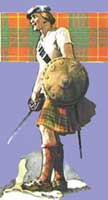 |
Another great Cameron was Sir Ewen, who was born in 1629 and died in 1719. The Duke of York Knighted Ewen in Edinburgh in the year 1682. Sir Ewen Cameron went on to fight at the famous Battle of Killiecrankie in 1689. He was loved by his soldiers as one of their own and was ferocious in a fight. The clan trusted and respected him. He was succeeded on his death by Donald Cameron ‘Gentle Lochiel' he was called. He wanted to try and help his clan to a better future. He was a man of vision and had great ideas for the clan as a whole. The Jacobite struggle in 1745 put paid to that. He was persuaded to rise with the other clans by His Royal Highness Charles Edward Stuart (Bonnie prince Charlie) after the disastrous battle of Culloden the clan lost most of their possessions for a while. They were eventually returned for a huge fine many years after Duncan was dead (1784). Duncan Cameron who was a truly great Cameron chief died in France in 1748. |
He never really got over allowing his clan to be talked into the Jacobite struggle because they had lost so much. He remained a staunch friend of Charles Edward Stuart until he died. Seemingly, while Donald was out during the 45, his grandson, Lieutenant Alexander Cameron, led the clan in the last three hours of Waterloo against the troops of Napoleon the first. Sir Alan, his son, went to America where, with the 84 th (also known as the Royal Emigrants), he helped to defend Quebec against the advances of Arnold . He raised the 79 Th or Cameron Highlanders in 1793.
Another Donald Cameron was a Member of Parliament for Inverness-shire in the year 1905 he was the twenty-fourth chief of the Cameron clan and worked at the job for seventeen years. He was also part of the Royal Commission which looked at the plight of crofters in the year 1883. The man who succeeded him was his son Donald and he successfully raised four new battalions of Cameronian Highlanders to fight in the First World War. |
Chief: Cameron of Lochiel
Clan Seat: Achnacarry, Spean Bridge
Plant: Oak
Memorials: None |
|
|
| Back to Top |
| Archambault, of Flemish origin, is the originator of this clan. His descendant married into the Scottish Lordship of the Gloume, near Stirling , and their later progeny married the heiress Eva O'Duine, thus gaining the Lordship of Lochaw, in Argyll, by marriage. As such, they became the chiefs of the Clan Diarmid. Neil Campbell of Lochaw was made Baillie of the land of Argyll by King Edward I of England (who claimed to be Lord Paramount of the whole Kingdom of Scotland ) in 1296. The Campbells fought with Robert the Bruce during the Wars of Independence. The great clan played its part in the final destruction of the numerically superior English army at the famous Battle of Bannockburn, which happened on the twenty-forth of June 1314. |
|
 |
It is interesting to note that in a parliament held by King Robert the Bruce in 1320 the spelling for the name registered as Campbell is actually ‘Sir Nigel de Campo Bello' James II of the Scots created the Lordship of Argyll and granted Lord Colin Campbell of Argyll the Earldom of Argyll in 1457. James III also created the title of Lord of Lorn for the Campbell heir of line in 1470.
Having been granted the title of Marquis of Argyll by King Charles I, the clan fought both King Charles I and his son Charles, Duke of Rothesay (later crowned King of Scots at Scone in 1651), when the Marquis led the Covenanters during the Civil Wars in the seventeenth century. |
It was due to the Marquis of Argyll that Charles the first was sold to Cromwell on the latter promise that Scottish Presbyterianism would become the National Church of England. The second Marquis supported William III of Orange 's invasion of England in 1688 and was created Duke of Argyll in 1701.
It was under the command of Robert Campbell of Glenlyon and two companies of Argyll's Regiment that the slaughter of the Maclaine of Glencoe, of the clan Macdonald, took place on February the thirteenth, 1692 . The real culprit is Sir John Dalrymple, Secretary of State for Scotland , who gave Glenlyon the order in the first place. Argyll voted in favour of the Treaty of Union of 1707. In 1706 his Grace the Duke of Argyll, made a campaign in Flanders, under the Duke of Marlborough, and rendered important services at various sieges and battles on the continent, and on December 20, 1710, he was installed a knight of the Garter. On the accession of George I, he was made groom of the stole, and one of the nineteen members of the regency, nominated by his majesty. On the king's arrival in England , he was appointed general and commander-in-chief of the king's forces in Scotland.3000 Campbells fought at Culloden against the Jacobite Army of Prince Charles Edward Stuart. There were, however, quite a few Campbells fighting on the Jacobite side as well. The main line died out in the eighteenth century and Chiefship devolved upon Campbell of Mamore, from whom the present chief is descended. |
Chief: Duke of Argyll
Clan Seat: Iveraray Castle
Plant: Wild (bog) Myrtle
Memorials: Kilmun Kirk |
|
| Back to Top |
| This clan has ties through marriage to be virtually Gaelic, as one of the Chisholm's married Margaret who was a Celtic Heiress of Erchless in the Aird. The clan is first recorded as having been a witness to a charter in the year of 1249. It is suggested that their family name comes from the plant Cheese-Holm which it is said that the Normans planted when the crossed the border at Robertson in Roxburghshire way back in the fifth century. In the year 1254 they (the family) are mentioned in a Papal Bull issued by Pope Alexander the fourth. In the year 1296 at the border town of Berwick a Clan member called Richard de Chesehelme paid homage to Edward the First of England and is recorded as having their name on the infamous ‘Rag Mans Roll' The seal he used to sign was depicted by a Boars head and is the same principal sign used by the Chisholm family clan to this day. |
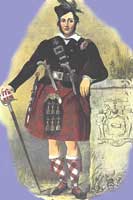 |
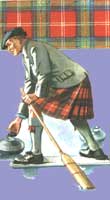 |
The Boars head on their seal was to commemorate a deed by two of the Chisholm brothers when they saved the Kings life as he was being attacked by a ferocious wild boar. Included in the Kings thanks was a large piece of land in Inverness-shire. The Chisholm family moved north to their new possession. The family went on to achieve great prominence in the North of Scotland. In the year 1359 A clan member Robert de Chisholme was installed as Constable of the magnificent Urquhart Castle on the beautiful shores of Loch Ness. Robert de Chisholme had fought for his King David the second at the battle of 1346 where he was actually taken prisoner. The Chief of the clan began being called ‘An Siosalach' meaning “The Chisholm” During the sixteenth century the clan remained Catholic and in fact provided three Bishops who opposed Protestant reformation. The clan did eventually change their religion and became Protestant. |
The Chisholm's were ‘out' during the Jacobite struggle for their rights in 1715 and as a consequence of that action they lost their lands which were forfeited to the crown. However they were given a pardon in 1727 and their lands were restored to them through purchase from Mackenzie of Allangrange. When Prince Charles Edward Stuart (Bonnie Prince Charlie) raised his standard at Glenfinnan the Chisholm's remained true and was with the Jacobite forces once again. Roderick a young son of the Chisholm was made Colonel of a Jacobite Battalion, and fell along with many of his fellow clansmen at the bloody Battle of Culloden in 1746. Of the Chisholm's who went to the Battle only fifty returned. The clan were not too severally punished for this brave deed as they had been more careful during the period and the clan had not openly supported the Stuart cause for the true monarchy to sit on the throne of Scotland . In the year 1810 the Chiefs of the clan sold all their lands and forced the Chisholm's into homelessness. Many of the clan found themselves heading for places like America or Australia .
A local bard added his words to the sad sight of the Chisholm homelands being taken for strangers and sheep to walk on. He wrote “The abode of warriors has withered away. The son of the lowlander is in your place” |
Chief: Chisholm of Chisholm
Clan Seat: Erchless Castle , and Comer, Strathglass
Plant: Fern
Memorials : None |
|
| Back to Top |
Humphrey Kirkpatrick was granted a charter for the lands of Colchoun, and Barony of Colquhoun during the reign of Alexander II. His son, Ingram, assumed the name of Colquhoun and married the ‘Fair Maid of Luss', thus acquiring that estate as well. The clan produced three branches. The first being, ‘ of that Ilk' , secondly, ‘ of Kirkpatrick' and thirdly, ‘ of Luss' . The Luss property and Rossdhu House became the principal family seat and chief of the Colquhoun Clan name. Iain Colquhoun was to be made Sheriff of Dumbarton in the year 1427. This unfortunate Colquhoun was murdered on Inchmurrin Island on bonnie banks of Loch Lomond , by the hand of the Macleans of Duart. |
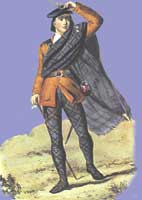 |
 |
The sixth Colquhoun laird of Camstradden was a renowned knight who fought at the battle of Pinkie in the year 1547.
The Colquhouns and Sir Humphrey, seventeenth Laird of Luss, fought the famous Highland Character Rob Roy MacGregor at Loch Lomond . The feud had been running for a long period of time and cattle stealing went on back and fourth. Now it was all out war between the two clans. The women of Colquhoun took the bloodied shirts of their men (some it is said was dipped in sheep blood) to James the sixth of Scotland , and asked his royal protection from the marauding Gregor or Macgregor. In the year 1603 the MacGregor clan consisting of about 400 men came into the Colquhoun lands and launched a savage attack. The MacGregor clan had already been dispossessed and so this led to the proscription of clan Gregor. |
When Charles the first inherited the crown in the year 1625, one of the first things he created was a new baronet of Nova Scotia in the name of Sir Iain Colquhoun, he was later to face charges in his native homeland that he had used witch craft to tempt his sister-in-law to run away with him. He never returned to Scotland to face the charge. Sir Humphrey Colquhoun represented Dumbarton in Parliament and was staunchly against the union of the parliaments in the early eighteenth century. The clan played little part in the Jacobite Struggle for truth in 1715 or the later struggle in 1745.Dying without a male heir in 1715, the Chiefship passed to Sir Humphrey's daughter and her husband, Grant of Pluscarden. On his succession, their son James Grant took the name of Sir James Colquhoun of Luss but had to resume to the name of Grant when he fell heir to the Grant estates.
During the First World War (1914-1918) Sir Iain Colquhoun was mentioned in dispatches no fewer than five times, and was wounded twice. He was created a Knight of the Thistle was Lord High Commissioner to the general Assembly of the Church of Scotland. He was also one of the main persons involved in the movement to save Scotland 's ancient heritage. |
Chief: Colquhoun of Luss
Clan Seat: Rossdhu, Luss, Dumbartonshire; Luss, barony, Dumbartonshire
Plant: Hazel
Memorials: None |
|
| Back to Top |
The family came to Scotland at the invitation of King David I from Flanders in Normandy and was related to King David's wife, Queen Maud of Senlis. They took the name from the barony of Crawfurd, in Lanarkshire, and were given lands in Galloway . Sir William Wallace, Guardian of the Realm of Scotland, was a descendant of the family through his mother, Margaret, daughter of Sir Hugh de Crawfurd and Sheriff of Ayr. Louden passed to the Crawfurd family and, in turn, came into the hands of the Campbells by marriage.
The family is mentioned throughout Scottish history in almost every generation and century. |
|
The Crawford/Crawfurd family clan held charters from many different sources. And the time span of the documentation is truly amazing. The records show that in 1127 there were two people of that name serving in King David the first's army.
Their names were as follows, Sir John Crawfurd and Sir Gregan Crawfurd. There is further mention of the name in the years 1170, 1190, 1228, 1230, and 1248. The Arms of Loudoun were quartered by Sir Reginald de Crawford in about the year 1200 when he married Margaret de Loudoun the heiress to that massive barony.
Margaret was the daughter of Sir Hugh Crawford; Sheriff of Ayr married Sir Malcolm Wallace of Elderslie, and became the mother of Scotland 's most famous and well loved son, the Patriotic Scottish giant William Wallace. He was the man who took Scotland 's Independence fight to the door of England . He was brutally hung drawn and quartered after a mock trial in London in the year 1705 having been caught near Robroyston in Glasgow he was walked to London then murdered. His body was dissected and sent to the four corners of the British islands by Edward the first of England . This was done as a lesson to the people of Scotland but unfortunately for Edward all it done was to galvanise the Scots cause.
Sir Reginald de Crawfurd, cousin of Sir William Wallace, was executed at Carlisle in 1307 for his loyalty to Robert the Bruce.
Crawfurd of Auchinames is the present chief and Crawfurd of Crawfurdland one of the principal cadet. |
Chief: Crawfurd of Auchinames
Clan seat: Auchinames, Lanarkshire
Plant: Boxwood
Memorials: None |
|
| Back to Top |
| These people are said to have come from Normandy , and it is thought that its name derives from Comines near Lisle in Northern France . It is also said that they came to the British Isles with William the Conqueror in 1066 and fought at the battle of Hastings . The first recorded name to be shown is Robert de Comyn who after coming to England was given lands in Northumberland. In the reign of David the first Robert de Comyns grandson William came north to Scotland and became chancellor of Scotland . His nephew Richard married a granddaughter of King Donald III Bane of the Scots. Their Scottish home was Badenoch, south east of Inverness . As the result of sound investment in the proper marriage partners the soon had holdings in several major places. |
 |
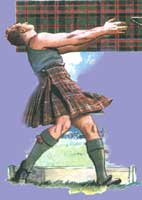 |
They were the holders of three Earldoms Monteith, Menteith and Athol and Buchan. John Comyn was slain at Alnwick in 1093 with King Malcolm III when trying to restore the Margaretsons on the throne of England .
Sir John, the Red Comyn, was Scotland 's Ambassador at the French Court of Louis IX in 1240 and first Lord of Badenoch. His son John was one of the 13 competitors to the Scottish crown in 1292 that supported the claim of John Balliol. His son, John, also referred to as the Red Comyn, fought against Edward I during the Wars of Independence and was stabbed to death by Robert the Bruce following a quarrel that took place within the holy precinct of the Church of Dumfries . |
The whole clan rose against the Bruce to revenge their chief but he defeated them and the Earl was both outlawed and his estates forfeited to the crown.The line died out and the Chiefship passed to one Jordanus Comyn, a distant kinsman, said to be the ancestor of the Cumins of Culter. At the time when Alexander the third 1248-1296 died when he fell from his horse on his way home to his new bride at Burntisland. Two Comyns both direct descendents of Duncan the first were elected to the council of six guardians of Scotland . They were very powerful men and their names were Alexander Comyn Earl of Buchan and ‘Black John' Comyn Lord of Badenoch. When the Young ‘Maid of Norway died'
The country of Scotland was in turmoil because there were six claimants to the Scottish crown. The Bruce fought with the Red Comyn in the Border town of Dumfries after agreeing to meet him. Bruce murdered him in the Church of the Grey Friars and for this act he was excommunicated as was the whole of the Scottish country once Bruce declared himself to be King. John Comyn was to be the last Lord of Badenoch who was surnamed Cumin. John's lands passed to the Earl of Buchan who was descended from another person called Cumin. The Cummings has held Altyre in Moray for many generations.
|
Chief: Cumming of Altyre
Clan Seat: Altyre, Forres; Durdargue Castle and Inverlochy Castle both Fraserburgh
Plant: Cummin Plant
Memorials : None |
|
| Back to Top |
In the year of 1162 Hugh de Moreville, granted to Warnebald who it is said was Flemish, the desirable property of Kilmaurs in the Cunningham district of Ayrshire. The Ayrshire coast at that period in history was under constant attack from marauding Vikings and people trying to assert their authority in the islands and coastal areas of western Scotland . Haakon the fourth of Norway , brought his fleet to bear on the coastline of Largs in the year 1263 in what was to become known as the Battle of Largs. Harvey Cunningham was to play his part in the defeat of the powerful Norwegian pirate and explorer.
The Cunningham family also appear on the infamous document created by Edward the first of England to humiliate and frighten the Scots peerage to do his bidding. |
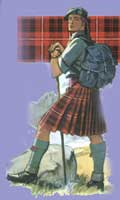 |
He had slaughtered the whole town of Berwick (then Scottish) and left the bodies to rot in the streets. He then forced the Scots to form a line and sign what became known as ‘The Rag Mans Roll' many of the Scottish people had to sign this allegiance to Edward but few meant it.
Robert the Bruce who was one of Scotland 's greatest Kings was indebted to the Cunningham family clan for their support in his struggle for Scottish independence. Now that Bruce had defeated the English army at Bannockburn he could start to repay his friends and allies who had aided him through all the bad times before his revenge against Edward the second. The Cunningham's were granted the lands of Lamburgton in 1321 by The King Robert the Bruce.
Alexander Cunningham the fifth earl was a bit of a despicable character and rouge. He sold Scotland 's cause for the sake of his own financial affairs and took English gold as his payment. When Charles the second was beaten at the battle of Worcester in 1653, the ninth earl tried to raise the people of the highlands in his defence. His bold efforts did not succeed but he was voted Scotland 's Lord Chancellor after the Restoration.
Robert burns the famous Scottish poet was very friendly with the Cunningham family and indeed wrote a few words for them from time to time. Here is a short verse from one about his friend Glencairn, who was the fourteenth earl of Cunningham.
The bridegroom may forget the bride
Was made his wedded wife yestreen
The monarch may forget his Crown
That on his head an hour has been
The mother may forget the child
That smiles sae sweetly on her knee
But I'll remember thee Glencairn
And a' that thou hast done for me.
|
Chief : Cunningham of Kilmaurs
Clan Seat: Kilmaurs
Plant: None
Memorials : None |
|
Click below to find other Scottish Clans
|
|
Back to Top
|